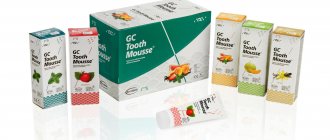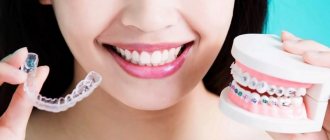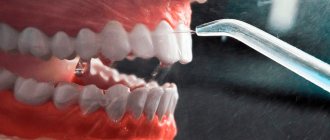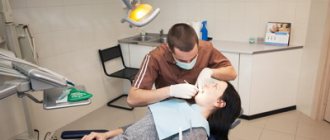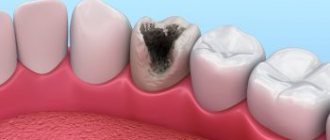One of the most common reasons for visiting a dentist is the treatment of dental caries. What methods are used in modern dental practice, whether it is possible to cure an affected tooth without preparation, we will talk about this in the article.
The development of dental caries is based on the consumption of large amounts of carbohydrate foods, insufficient oral hygiene, and the accumulation of food debris on the teeth and in the interdental spaces. All this serves as a favorable environment for the proliferation of cariogenic microbes.
In this article
- What methods do dentists use to combat caries?
- Technology for treating enamel caries in the spot stage
- Modern technology for treating caries without preparation
- Technology for caries treatment using ozone therapy
- New technologies for caries treatment using laser
- When are invasive caries treatment methods used?
- Basic principles of cavity preparation
- How are carious cavities prepared?
- Mechanical and chemical-mechanical preparation
- Air-abrasive method of preparation
- Laser preparation
- Surgical treatment of caries
They ferment sugar and produce acid, which destroys tooth enamel, dentin and other tooth tissues. The higher the concentration of bacteria in plaque, the more acid they produce, and the faster caries develops.
What methods do dentists use to combat caries?
All methods of treating dental caries can be divided into two large groups - invasive and non-invasive. The first involves treating enamel caries without preparation. This option is most often used when the carious lesion is in its initial stage, there is no extensive damage to the deep tissues of the tooth, or there are indications for anesthesia.
Invasive technologies are used much more often and involve tooth preparation and removal of tissue affected by caries. The degree of preparation depends on how severely and deeply the tooth is affected.
The optimal treatment regimen and method is always selected by the dentist, taking into account age, individual characteristics, stage of disease development, anesthesia tolerance and other factors.
Technology for treating enamel caries in the spot stage
A symptom of early caries is a small light spot on the surface of the tooth enamel. This area is a focus of demineralization, that is, in this area the enamel began to lose minerals. At this stage, it is possible to restore the normal structure of the enamel by replenishing the lack of mineral components.
The main method of treating caries at this stage is remineralizing therapy. It can be performed either in the dentist's office or at home. Home remineralization involves the following procedures:
- The use of medicated toothpastes and gels with fluoride, calcium and phosphorus.
- As prescribed by the dentist, a course of mousse or gel applications with phosphates and calcium. Usually they are carried out in courses of 10 days, repeating every month.
Professional remineralization of tooth enamel is carried out by a doctor. It may include several types of procedures:
- Simple fluoridation.
Coating teeth with fluoride-containing gels, solutions, varnishes, applying calcium and fluoride-containing preparations. These procedures are performed after comprehensive professional teeth cleaning. At the same time, the carious stain, even after remineralizing therapy, does not always disappear completely. The earlier treatment of dental caries in the stain stage is started, the better the prognosis.
- Deep fluoridation.
This method of caries treatment involves the use of special drugs that seal the tooth enamel. This approach ensures the deposition of fluoride in dental tissues, which is important for long-term exposure to fluoride.
Modern technology for treating caries without preparation
An alternative to remineralizing therapy at the stage of a carious spot or superficial caries can be a modern infiltration method. With this technology, it is possible to avoid the most uncomfortable stages of dental treatment - anesthesia and preparation.
This technique assumes that a drill is not used for dental treatment and an anesthetic injection is not given. The essence of the procedure is that a synthetic gel-polymer penetrates the layer of tooth enamel that is affected by caries. The high fluidity resin included in its composition prevents acids and toxins released by bacteria from penetrating the porous enamel. Thus, the development of caries is blocked at an early stage. The technology helps treat tooth enamel, thicken and strengthen it. Infiltration therapy increases the resistance of enamel to negative environmental influences. In some cases, ICON allows you to return your teeth to their natural, even color and enamel transparency.
The procedure is carried out in several stages:
- First, the affected tooth is treated with a special gel that cleans the surface layer of enamel.
- Then, using a special type of alcohol, the tooth surface is dried.
- At the third stage, the tooth is covered with a special infiltrant - this is a composite that seals the enamel pores.
The procedure is performed very quickly and does not cause discomfort to the patient. However, treatment of caries using the ICON method is recommended only for initial damage to the enamel. The technology is not suitable for the treatment of medium or deep caries, and, unlike fluoridation, it is not used for preventive purposes.
Use of ozone
Ozone is used mainly for caries. This is also a painless modern method that allows you to completely eliminate the use of a drill. The essence of the procedure is to completely disinfect the affected area of the tooth. After treating the tooth with ozone and destroying all pathogenic microorganisms, its surface is coated with an enamel-restoring composition. The entire disinfection procedure takes no more than half a minute. The advantages of this method:
- there is no need to use a drill to penetrate the affected area of the tooth;
- high speed of operation;
- complete disinfection;
- painless operation, which makes the use of ozone especially popular in pediatric dentistry.
The disadvantage is that its use is not always possible. There are deep dental lesions when it is impossible to get to the desired area without a drill.
Technology for caries treatment using ozone therapy
This is one of the new methods, which is based on the oxidizing effect of ozone. By acting on the tooth, it promotes the death of cariogenic microbes, neutralizes acids produced by bacteria, allowing the mineral components of saliva to restore the mineral balance of tooth enamel.
Ozone therapy is performed in a dental clinic using special equipment. The procedure is painless and lasts about 30 seconds. Ozone penetrates the biological film in a matter of seconds, destroys microbes and cleanses dental tissue. After ozone therapy, remineralization is usually carried out or fissures (natural depressions in the teeth) are sealed.
Content:
- Modern dental treatment - advances that have played a decisive role in the development of the industry 1.1. Use of computer technology 1.2. Laser in dentistry 1.3. Ozone in the field of dentistry 1.4. Air grinding of dental crowns 1.5. Innovative anesthetics that guarantee the absence of pain 1.6. Modern materials for filling, prosthetics and implantation
Dentistry is a field of medicine that is developing at an incredibly fast pace.
Modern methods of dental treatment surprise and delight. Today, dentists offer their patients techniques that allow them to eliminate existing functional and aesthetic deficiencies in the oral cavity without pain or harm to health. Doctors manage to “rehabilitate” seriously damaged units and return them to beautiful visuals. Even the most complex malocclusions, which negatively affect the appearance of the face, aesthetics and the process of chewing food, are eliminated by doctors at private dental clinics quite quickly.
New technologies for caries treatment using laser
Another non-invasive method in which a laser beam non-contactly affects the affected tooth tissue without affecting healthy ones. The method has both pros and cons.
Main advantages:
- there is no need for anesthesia because the treatment is painless;
- You can treat teeth with laser from childhood;
- the laser beam destroys microbes and seals blood vessels, the risk of complications after such treatment is minimal;
- laser equipment does not make frightening and unpleasant sounds like a drill, so even small patients do not experience fear during the procedure;
- the device allows you to control the laser penetration depth and impact power;
- Unlike dental burs, the laser beam does not leave microcracks in the enamel.
The disadvantages of the method include the relatively high cost of treatment and the need to protect the eyes with special glasses. Like other non-invasive methods, laser therapy is effective only in the initial stages of caries.
Can an injection be painless?
Patients often have a fear of anesthesia injection. To reduce discomfort, ILATAN dental doctors:
- Use special syringes with very thin needles;
- Dry the mucosal area before injection to facilitate the passage of the needle;
- Lubricate the injection sites with anesthetic gel;
- The medicine is administered gradually.
When are invasive caries treatment methods used?
Not everyone goes to the dentist at an early stage, when caries is just a light spot on the enamel. This is due to the fact that in the initial stage the disease is not accompanied by pain, discomfort and other noticeable symptoms. Similar signs appear already at the stage of medium or deep caries, when the lesion has affected the dentin and a cavity has formed in the tooth. In such cases, when treating teeth with caries, one cannot do without preparing, cleaning and filling cavities.
The algorithm for invasive treatment of caries consists of several stages:
- First, the tooth is numbed with an anesthetic injection. People who are allergic to anesthesia or have a high sensitivity threshold sometimes have their teeth treated without anesthesia.
- The dentist cleans the surface of the tooth from plaque.
- Using a special plate, it isolates the tooth from saliva, since the cleanliness and dryness of the treated area directly affects the effectiveness of the treatment.
- The dentist then removes the tissue affected by tooth decay. Most often, using a drill, but other methods are also possible.
- After removing all the affected tissue, treating the cavity with acid and adhesive for better adhesion of the filling to the walls, the doctor restores the anatomically correct shape of the tooth using a filling. Light-curing fillings are considered the most modern and reliable. They are applied in layers, with each layer illuminated with a special lamp.
- After installing the filling, it is adjusted to the bite, polished and ground. At this point, the treatment of caries is considered complete.
Bite correction
The beauty of a smile is influenced by both the whiteness of the teeth and the bite. In addition, due to the uneven distribution of the load on the teeth, malocclusion can cause serious periodontal diseases. Also, with an incorrect bite, the conditions for brushing teeth worsen, which can become one of the causes of caries. An incorrect bite makes it difficult to chew food , which can lead to diseases of the digestive system.
It is possible to correct the bite both in childhood and in adulthood. Although in adulthood this procedure has some peculiarities. Thus, getting rid of malocclusion in adults takes longer, and before treating the bite, you need to get rid of inflammatory diseases of the mouth.
permanent braces are used to treat malocclusion in adults . They are special brackets that are secured with glue to the tooth enamel. Braces systems are selected for each patient individually, which ensures wearing comfort. Now these systems are made of ceramics, which does not differ in color from enamel, or from transparent materials, which makes such systems invisible to people around them.
silicone aligners can be used to treat simple cases of malocclusion . Such mouthguards do not cause discomfort and are invisible to strangers. Orthodontic plates are used to realign the jaw bones and help break bad chewing habits. For minor malocclusions, trainers are used.
In case of severe malocclusion and incorrect position of the jaw bones, surgical intervention is necessary. Very good results can be obtained by combining the two methods, when correction with braces is performed after surgery.
Basic principles of cavity preparation
Preparing the cavity of a diseased tooth is one of the most important stages in the treatment of caries.
Modern methods require a special approach to the preparation of carious cavities. Professional dentists follow five basic principles when performing this procedure:
- Biological feasibility.
All dental tissue affected by caries must be excised.
- Gentle treatment of dental tissues.
The dentist chooses an approach to caries treatment that will maximize the preservation of healthy tissue.
- Compliance with aseptic and antiseptic requirements.
All instruments that come into contact with teeth, oral mucosa, saliva and blood must be sterile. If technologies are used that create aerosols in the air, it is necessary to use eye and respiratory protection.
- Painless manipulations.
Any painful interventions are carried out only with the use of anesthetic drugs. During the preparation process, the dentist observes a number of conditions that make cavity treatment minimally painful: he works only with sharp burs, prepares the cavity with intermittent movements, uses the air-water cooling method, uses high-speed tips, etc.
- Biomechanical compliance.
The shape of the carious cavity must correspond to the physical and mechanical properties of the filling material and dental tissues that surround the cavity.
Mechanical and chemical-mechanical preparation
With the mechanical method, the carious cavity is prepared using hand instruments and dental burs. This option is the most common.
During chemical-mechanical preparation, the dentist first acts on the affected dental tissues with special solutions and gels that destroy the areas affected by caries. And then, using hand instruments, he cleans the cavity and fills it.
There is also an ART technique developed in Russia, in which the affected tissue is first removed with a hand instrument, then gels with different effects are applied one by one. The treatment is completed by re-cleaning the cavity using instruments and rinsing with water.
Air-abrasive method of preparation
Essentially, this is sandblasting the hard tissues of a diseased tooth. Through a special tip, an aerosol containing water and an abrasive substance is applied to the surface of the tooth. This method is used before sealing fissures or to remove pigmented areas of tooth enamel.
The air abrasive method can be used to prepare small carious cavities. The advantages of this method are minimal tissue excision and the creation of a rough surface that does not require additional acid etching.
The structure of the human tooth
Each tooth consists of a crown - a part of the tooth protruding above the surface of the gum, a root immersed in the bone socket of the jaw; The crown and root of the tooth are separated by a neck.
The crown of the tooth is covered with enamel, the hardest tissue of the human body. Beneath the enamel is dentin, a bone-like tissue that makes up the bulk of the tooth. The root of the tooth is covered with cementum, a thin layer of tissue that resembles bone in structure. Inside the crown and root there is a cavity filled with soft tissue - pulp. The pulp consists of loose connective tissue, vessels, nerves and various cells.
In the jaw, the teeth are held in place by tissues called periodontium.
Laser preparation
With this method, the dentist uses pulsed lasers specially designed for dental treatment. The device consists of three basic elements - the main block, which produces radiation of a specific frequency and power, as well as a light guide and a tip. It is with the help of the tip that the dentist performs manipulations in the patient’s oral cavity. The tips come in different shapes, but all have a cooling system.
The process of laser tooth preparation is carried out in this way. The base unit produces laser beams. Getting on the hard tissues of the teeth, they heat the moisture contained in them. Something like an explosion occurs, which leads to microscopic destruction in the tooth enamel and dentin. At the same time, nearby tissues heat up slightly. Then, using a spray of water and air, particles of dental tissue are removed from the oral cavity. What is the advantage of laser preparation compared to mechanical preparation? In the first case, there is no irritation of nerve endings and strong heating of hard tissues, so the laser procedure is painless and does not require anesthesia. Also, laser treatment of the cavity is more controlled and faster, and the surface of the carious cavity after laser treatment does not require additional etching.
After preparation, the dentist treats the carious cavity with medication and installs a filling. In some cases, after filling it is necessary to additionally remineralize the tooth.
Kind words from our patients
Proklov Leonid
Having received a consultation at the Adequate Dentistry clinic, I decided to take care of my upper teeth - they were very sensitive to temperature. The doctor recommended installing light fillings. They did it very quickly - I had 3 teeth filled in an hour. The filling cannot be distinguished from a tooth by its shade and shape. I also recommend this dentistry to those who have fears. The specialists are very careful and confident, they know how to calm you down. Thank you for your sensitive treatment and good work.
Vasily Lopatin
I took a vacation specifically to finally get my teeth fixed. It was possible to correct the upper teeth using cosmetic fillings at Adequate Dentistry. It was not possible to seal the lower ones with fillings, but they installed excellent crowns and metal-ceramics. Before arriving, I ordered a treatment plan, sent my dental image to the clinic specialists, and found out the cost of treatment. In general, now I have healthy, beautiful teeth, thanks to your doctors!
Spatova Valeria
Suddenly I had a toothache, I immediately rushed to look for a clinic on the Internet, of course there are many of them, so try to guess. I came across the Adequate Dentistry clinic and decided to stop there. A polite girl answered the call and made an appointment. I was very afraid, since I’ve never had problems with my teeth, and I didn’t even have a lot of treatments, but as a result, several teeth were cured, a neglected tooth root was treated, and everything went painlessly. When I went to the appointment, I was trembling with fear, but I left the office with a smile. Thank you!
Surgical treatment of caries
Surgery may be required in the following cases:
- if drug methods turned out to be ineffective in the treatment of deep caries;
- if caries is complicated by other diseases.
Depending on the complexity, surgical treatment can be performed both in a hospital and on an outpatient basis.
The best way to avoid surgery is to see your dentist promptly and treat tooth decay in its early stages. Remember: the sooner you see a dentist, the faster, simpler, painless and affordable the treatment will be.
